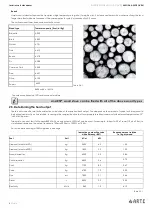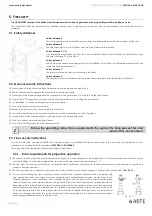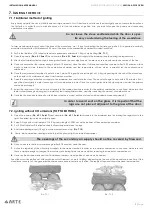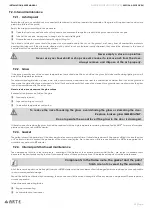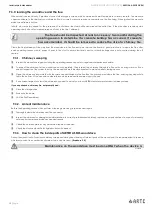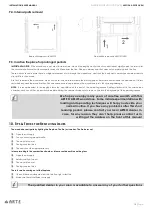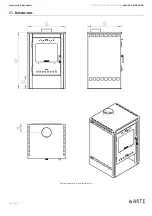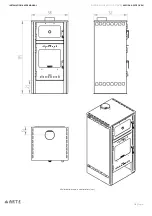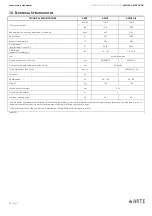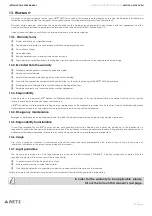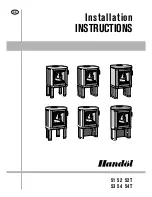
I
NSTALLATION
&
USER MANUAL
ENERGY EFFICIENT WOODSTOVE
| ASSOS & ASSOS OVEN
10 |
Page
Wood combustion rules
If you want less heat, put a smaller quantity of wood in the woodstove and reduce the amount of air. It is however important to maintain
an adequate layer of cinder.
Less heat = Less wood = Less air.
More heat = More wood = More air.
When the woodstove operates at excessively low power or if the wood is not sufficiently dry, soot might deposit on the glass.
8.
T
ERTIARY COMBUSTION
The two combustion points
The combustion of wood requires a process of primary, secondary, and tertiary combustion to be efficient.
1.
Primary combustion
Primary combustion is the initial wood burning at relatively low temperatures. During
the primary combustion, large amounts of soot, creosote and gas are produced
due to the existence of water in the wood. Creosote, in primary combustion,
contains 60% of the potential energy of wood, but it is deposited in the form of soot
inside the woodstove and the flue without imparting any heating.
2.
Secondary combustion
The combustion chamber is insulated so as to increase the temperature of the core
and by providing just the right amount of oxygen necessary to 600
O
C, the creosote
ignites spontaneously. This creates a chain reaction that increases the temperature
inside the woodstove from 600
O
C to about 870
O
C without having to add any more
fuel. This is the secondary combustion.
Thereby, the more proper secondary combustion is achieved the higher temperatures are produced and the
less residue is left (gas and particles). The vast majority of secondary combustion is only done in the upper part
of the chamber near the outlet of the flue. Thus a large part of the heat that
is achieved, is discharged directly through the draft of the flue to the exterior
and not in the heating area.
ARTE’s® combustion chamber manages to provide the maximum secondary combustion performance. The
air intake regulating system in cooperation with two vertical ducts having openings (
Pic. 8.1.1
), in such a
way as to insert the appropriate amount of hot air through the entire length of the pipeline, onto the
calcined side of the combustion space and the aircurtain of the ceramic glass, results in the fire receiving
the right amount of preheated oxygen throughout the combustion chamber (
Pic. 8.1.2, Pic. 8.1.3
). This way
the whole area of the chamber is converted in a secondary combustion chamber, not only the upper part,
and thus its performance dramatically increasies and inversely gas residue reduces.
9.
C
LEANING
&
M
AINTAINING THE
W
OODSTOVE
9.1.
External maintenance
The stove surface is painted with heat-resistant paint. It is best kept clean by vacuuming with a soft brush attachment or by wiping with a lint-
free cloth. Over a period of time, the painted surface may become slightly grey. A canister of touch-up ARTE
®
spray paint should be available
from your woodstove supplier. This can be applied - in accordance with the instructions - in just a few minutes. When first firing, after touching
up, the woodstove will give off a slight smell as the paint cures. Make sure to ventilate the room well during this phase.
Εικ. 8.1.2
Εικ. 8.1.1
Εικ. 8.1.3
When performing maintenance on the woodstove, always
protect yourself, using safety goggles and gloves
The fire should be vigorous and the smoke exiting from the flue must be almost
unnoticeable.
The fire should not be smoldering because it is causing more pollution.
If the door remains slightly open, fire gases and flames may escape from the
opening of the woodstove causing a risk of fire or asphyxiation. We recommend
installing a smoke detector in the room where the woodstove is located.
Under no circumstance should you operate the woodstove with the main door
open. You run a serious risk of destroying the device.
DO NOT OVERHEAT THE WOODSTOVE! There is risk of fire or permanent damage. If
any part of the woodstove starts glowing, then the device is overheating.
Summary of Contents for ASSOS
Page 1: ......
Page 19: ...INSTALLATION USER MANUAL ENERGY EFFICIENT WOODSTOVE ASSOS ASSOS OVEN 18 Page NOTES S N...
Page 20: ......





